Related Research Articles

Sodium is a chemical element with the symbol Na and atomic number 11. It is a soft, silvery-white, highly reactive metal. Sodium is an alkali metal, being in group 1 of the periodic table. Its only stable isotope is 23Na. The free metal does not occur in nature, and must be prepared from compounds. Sodium is the sixth most abundant element in the Earth's crust and exists in numerous minerals such as feldspars, sodalite, and halite (NaCl). Many salts of sodium are highly water-soluble: sodium ions have been leached by the action of water from the Earth's minerals over eons, and thus sodium and chlorine are the most common dissolved elements by weight in the oceans.

Sodium bicarbonate (IUPAC name: sodium hydrogencarbonate), commonly known as baking soda or bicarbonate of soda, is a chemical compound with the formula NaHCO3. It is a salt composed of a sodium cation (Na+) and a bicarbonate anion (HCO3−). Sodium bicarbonate is a white solid that is crystalline, but often appears as a fine powder. It has a slightly salty, alkaline taste resembling that of washing soda (sodium carbonate). The natural mineral form is nahcolite. It is a component of the mineral natron and is found dissolved in many mineral springs.
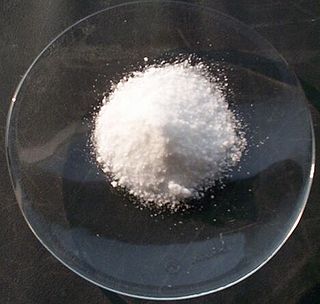
Potassium chloride is a metal halide salt composed of potassium and chlorine. It is odorless and has a white or colorless vitreous crystal appearance. The solid dissolves readily in water, and its solutions have a salt-like taste. Potassium chloride can be obtained from ancient dried lake deposits. KCl is used as a fertilizer, in medicine, in scientific applications, domestic water softeners, and in food processing, where it may be known as E number additive E508.
A substance is pyrophoric if it ignites spontaneously in air at or below 54 °C (129 °F) or within 5 minutes after coming into contact with air. Examples are organolithium compounds and triethylborane. Pyrophoric materials are often water-reactive as well and will ignite when they contact water or humid air. They can be handled safely in atmospheres of argon or nitrogen. Class D fire extinguishers are designated for use in fires involving pyrophoric materials. A related concept is hypergolicity, in which two compounds spontaneously ignite when mixed.

Potassium bicarbonate (IUPAC name: potassium hydrogencarbonate, also known as potassium acid carbonate) is the inorganic compound with the chemical formula KHCO3. It is a white solid.
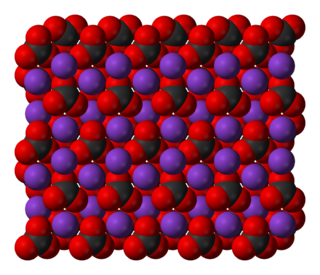
Potassium carbonate is the inorganic compound with the formula K2CO3. It is a white salt, which is soluble in water. It is deliquescent, often appearing as a damp or wet solid. Potassium carbonate is mainly used in the production of soap and glass.
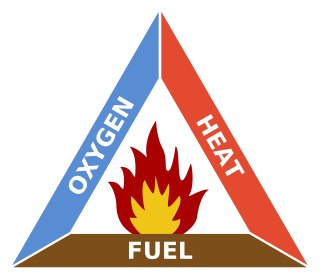
The fire triangle or combustion triangle is a simple model for understanding the necessary ingredients for most fires.

Fire control is the practice of reducing the heat output of a fire, reducing the area over which the fire exists, or suppressing or extinguishing the fire by depriving it of fuel, oxygen, or heat. Fire prevention and control is the prevention, detection, and extinguishment of fires, including such secondary activities as research into the causes of fire, education of the public about fire hazards, and the maintenance and improvement of fire-fighting equipment.

Potassium citrate (also known as tripotassium citrate) is a potassium salt of citric acid with the molecular formula K3C6H5O7. It is a white, hygroscopic crystalline powder. It is odorless with a saline taste. It contains 38.28% potassium by mass. In the monohydrate form, it is highly hygroscopic and deliquescent.
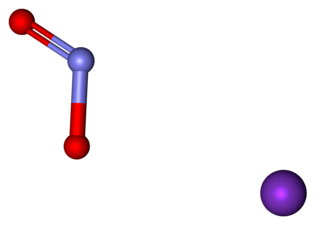
Potassium nitrite (distinct from potassium nitrate) is the inorganic compound with the chemical formula KNO2. It is an ionic salt of potassium ions K+ and nitrite ions NO2−, which forms a white or slightly yellow, hygroscopic crystalline powder that is soluble in water.

A fire retardant is a substance that is used to slow down or stop the spread of fire or reduce its intensity. This is commonly accomplished by chemical reactions that reduce the flammability of fuels or delay their combustion. Fire retardants may also cool the fuel through physical action or endothermic chemical reactions. Fire retardants are available as powder, to be mixed with water, as fire-fighting foams and fire-retardant gels. Fire retardants are also available as coatings or sprays to be applied to an object.
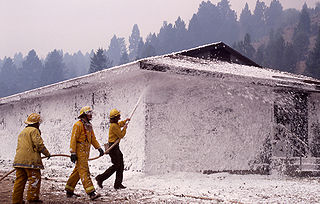
Firefighting foam is a foam used for fire suppression. Its role is to cool the fire and to coat the fuel, preventing its contact with oxygen, thus achieving suppression of the combustion. Firefighting foam was invented by the Russian engineer and chemist Aleksandr Loran in 1902.
Active fire protection (AFP) is an integral part of fire protection. AFP is characterized by items and/or systems, which require a certain amount of motion and response in order to work, contrary to passive fire protection.
A fire class is a system of categorizing fire with regard to the type of material and fuel for combustion. Class letters are often assigned to the different types of fire, but these differ between territories. There are separate standards for the United States, Europe, and Australia. This is used to determine the type of extinguishing agent that can be used for that fire class.
A twin-agent fire extinguishing system (TAFES), also commonly referred to as a twin-agent unit (TAU), incorporates the benefits of dry chemical and foam fire extinguishing agents. It is most commonly used for AR-FF operations and in industrial areas with high class B hazards.

Monoammonium phosphate, ABC Dry Chemical, ABE Powder, tri-class, or multi-purpose dry chemical is a dry chemical extinguishing agent used on class A, class B, and class C fires. It uses a specially fluidized and siliconized monoammonium phosphate powder. ABC dry chemical is usually a mix of monoammonium phosphate and ammonium sulfate, the former being the active component. The mix between the two agents is usually 40–60%, 60–40%, or 90–10% depending on local standards worldwide. The USGS uses a similar mixture, called Phos Chek G75F.
Commonly referred to as "Fast Flow" or "High Performance" extinguishers. Available in 6 kg (13 lb), 9 kg (20 lb), and 14 kg (30 lb). capacities and contain ABC Dry Chemical, Purple-K, or sodium bicarbonate. They are currently manufactured by Ansul in cartridge-operated form, along with Amerex, Badger and Buckeye stored pressure design.

A fire extinguisher is a handheld active fire protection device usually filled with a dry or wet chemical used to extinguish or control small fires, often in emergencies. It is not intended for use on an out-of-control fire, such as one which has reached the ceiling, endangers the user, or otherwise requires the equipment, personnel, resources, and/or expertise of a fire brigade. Typically, a fire extinguisher consists of a hand-held cylindrical pressure vessel containing an agent that can be discharged to extinguish a fire. Fire extinguishers manufactured with non-cylindrical pressure vessels also exist but are less common.

Condensed aerosol fire suppression is a particle-based form of fire extinction. It is similar to dry chemical fire extinction).

In fire classes, a Class B fire is a fire in flammable liquids or flammable gases, petroleum greases, tars, oils, oil-based paints, solvents, lacquers, or alcohols. For example, propane, natural gas, gasoline and kerosene fires are types of Class B fires. The use of lighter fluid on a charcoal grill, for example, creates a Class B fire. Some plastics are also Class B fire materials.
References
- ↑ Glenn Corbett (ed.), Fire Engineering's Handbook for Firefighter I and II Penn Well 2009, ISBN 1593701357 page 98
- 1 2 Fire extinguishing powders. A. E. Finnerty US. Army Research Laboratory, L. J. Vande Kieft. Halon Options. Technlcal Working Conference 6-8 May 1997.
- ↑ Dry Chemical Agents- Purple-K in Chemguard
- ↑ "Purple K Powder", "Naval Aviation News", September 1959, page 19,